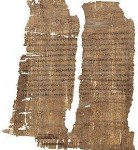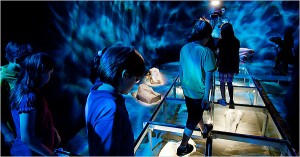 A new exhibit of 150 artifacts from Cleopatra’s Egypt opens today at The Franklin Institute in Philadelphia.
A new exhibit of 150 artifacts from Cleopatra’s Egypt opens today at The Franklin Institute in Philadelphia.
Organized by National Geographic and Arts and Exhibitions International in cooperation with the Egyptian Supreme Council of Antiquities and the European Institute for Underwater Archaeology (IEASM), Cleopatra: The Search for the Last Queen of Egypt puts on display for the first time in the United States jewelry, coins, religious items, even colossal statues raised from the the Bay of Aboukir, off the coast of Alexandria.
 There’s even an original papyrus document with an inscription that archaeologists think was written in Cleopatra’s own hand. The document grants a tax break from sales of imported wine to Roman businessman Publius Canidius, a friend of Mark Antony. It’s inscribed “make it happen” in Greek, and that’s the bit that is thought to have been printed by Cleopatra herself. Very Jean Luc Picard.
There’s even an original papyrus document with an inscription that archaeologists think was written in Cleopatra’s own hand. The document grants a tax break from sales of imported wine to Roman businessman Publius Canidius, a friend of Mark Antony. It’s inscribed “make it happen” in Greek, and that’s the bit that is thought to have been printed by Cleopatra herself. Very Jean Luc Picard.
After Egypt succumbed to Roman forces and Cleopatra famously took her own life following the suicide of her lover Mark Antony, the Romans attempted to wipe her legacy from the pages of history. Cleopatra thus has remained one of history’s greatest enigmas, and her final resting place is one of Egypt’s unsolved mysteries. The artifacts in this exhibition are woven into the story of her rule and life in ancient Egypt during her dynasty (Ptolemaic period). The story of her life and time unfolds in a dramatic setting with high-definition multimedia, original soundscapes and a mobile-based social media experience. Additionally each guest receives an audio tour with admission that provides a rich background to the featured artifacts. […]
The exhibition also showcases artifacts from [underwater archaeologist and director of IEASM] Franck Goddio’s continuing underwater search off the Mediterranean coast of Egypt, begun in 1992 and sponsored by the Hilti Foundation. Goddio’s remarkable finds bring visitors inside his search for the lost world of Cleopatra, including remnants from the grand palace where she ruled. Visitors also see underwater footage and photos of Goddio’s team retrieving artifacts from the ocean and bringing them to the surface for the first time in centuries.
“The aim of our work is to reveal traces of the past and bring history back to life. We are delighted to present our underwater archaeological achievements and discoveries off the coast of Egypt to the American public,” said Franck Goddio.
The exhibit has two agendas that I can detect, one stated and one not. The stated one is to rehabilitate Cleopatra’s reputation, long since besmirched by the victorious Romans who wrote that particularly piece of history. The unstated one is to promote Zahi Hawass’ search for Cleopatra and Mark Antony’s tomb at the Taposiris Magna site. The press release about the exhibit dedicates a couple of paragraphs to Hawass’ excavation, and National Geographic’s website on the show has a whole page about it, plus links to previous stories.
Keeping that caveat in mind, the exhibit is a powerful, full-immersion voyage into Cleopatra’s world, even taking visitors under water to find her. Cleopatra will remain at the Franklin through January 2, 2011, after which it will travel to 5 other US cities, as yet unannounced.
